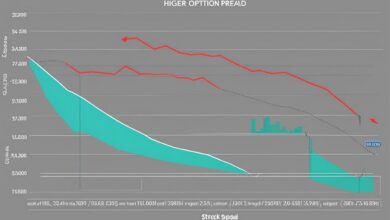Sector Rotation Strategies Using Options: Identifying and Capitalizing on Market Cycles

Introduction
Sector rotation strategies are important in options trading because they allow investors to switch their attention between different sectors depending on the current stage of the economic cycle. These strategies enable you to predict and take advantage of market cycles, improving your chances of getting the best investment results.
In this article, we will explore advanced sector rotation strategies that involve options. You will discover how to recognize and benefit from market cycles, using these strategies to achieve better investment performance.
Understanding Sector Rotation in Depth
Sector rotation is a strategy that involves shifting investments among various sectors based on the different stages of the economic cycle. This approach hinges on the principle that different sectors perform better during specific phases of the business cycle, thereby offering opportunities for strategic asset allocation.
The Economic Cycle and Business Cycle Phases
The economic cycle typically encompasses four main stages:
- Recession
- Early Recovery
- Late Recovery
- Expansion
Each stage impacts sector performance differently:
- Recession: Characterized by declining economic activity, reduced consumer spending, and lower business investment. During this phase, sectors like consumer staples and utilities tend to outperform as they provide essential goods and services that remain in demand regardless of economic conditions.
- Early Recovery: Marked by improving economic indicators such as rising GDP and falling unemployment rates. Cyclical sectors like industrials and basic materials benefit from increased economic activity. Investors may leverage options in these sectors to capitalize on anticipated growth.
- Late Recovery: As the economy continues to grow, energy and consumer discretionary sectors see substantial gains. These industries often experience higher demand due to increased consumer confidence and spending.
- Expansion: This stage involves robust economic growth, often leading to inflationary pressures. Technology and financial sectors usually thrive during expansion, driven by innovation and increased lending activities.
Practical Implications for Options Traders
Options traders can effectively utilize sector rotation strategies to enhance returns during different business cycle phases:
- Bull Call Spreads: Ideal for bullish market conditions, particularly during early recovery or expansion phases when specific sectors show strong growth potential. For instance, a trader might use bull call spreads on technology stocks during an expansion phase to maximize gains while limiting risk.
- Covered Calls: Useful for generating income from stable or slightly bullish sectors such as utilities during recessions or late recovery phases. This strategy involves holding a long position in a stock while selling call options to earn premium income, which is a key aspect of covered call trading.
Sector Identification and Leveraging Options
Identifying which sectors excel in each phase of the economic cycle allows traders to align their options strategies accordingly:
- Full Recession: Focus on consumer staples and utilities.
- Early Recovery: Leverage cyclical sectors like industrials and basic materials.
- Late Recovery: Target energy and consumer discretionary sectors.
- Expansion: Emphasize technology and financials.
By understanding these dynamics, options traders can anticipate market movements and position themselves to capitalize on opportunities across different economic cycles.
Advanced Sector Rotation Strategies for Options Trading Success
Expert Options Strategies for Targeted Sector Exposure
To optimize investment returns, implementing advanced options strategies within an active investment strategy is essential. Specific options strategies can be tailored to capitalize on different phases of the economic cycle, ensuring effective portfolio management. Here, we delve into two specialized options strategies: Bull Call Spreads and Covered Calls.
 Bull Call Spreads
Bull Call Spreads
Bull Call Spreads are a popular strategy among options traders looking to profit from rising prices in a specific sector. This strategy involves buying a call option at a lower strike price while simultaneously selling another call option at a higher strike price within the same expiration period.
Optimal Market Conditions for Use:
- Rising Markets: Ideal during bullish market conditions or early recovery phases.
- Sector-Specific Growth: Effective when specific sectors show potential for growth due to economic indicators.
Risk-Reward Analysis:
- Limited Risk: The maximum loss is confined to the net premium paid.
- Capped Profit Potential: Profit is limited to the difference between the strike prices minus the net premium.
- Break-Even Point: Calculated as the lower strike price plus the net premium paid.
Example: If you anticipate growth in the technology sector during an early recovery phase, you might buy a call option on a tech ETF with a $50 strike price and sell another call option with a $60 strike price. If the ETF rises to $60 or higher, you maximize your profit.
Covered Calls
Covered Calls involve holding a long position in an underlying asset while writing (selling) call options on that same asset. This strategy generates income from stable or slightly bullish sectors and includes downside risk management through protective puts.
Generating Income:
- Premium Collection: Earn premiums from selling call options.
- Stable Sectors: Best used in sectors with minimal volatility and moderate growth expectations.
Managing Downside Risk:
- Protective Puts: Purchasing put options on the same asset can protect against significant declines.
Example: Holding shares of a consumer staples ETF during an early recession phase and selling call options against these shares can generate additional income. To mitigate risk, you might also purchase put options on the ETF.
Advantages:
- Income Generation: Regular premiums provide steady income.
- Downside Protection: Protective puts limit potential losses.
Drawbacks:
- Capped Upside Potential: Gains are limited if the underlying asset appreciates significantly.
Scenario: You own 100 shares of an industrials ETF currently trading at $80 per share. You sell one call option with a $90 strike price for a premium of $3 per share. If the ETF trades below $90 by expiration, you keep the premium and potentially sell another covered call.
Implementing these advanced strategies requires understanding market cycles and identifying which sectors are poised to outperform at different stages. By tailoring Bull Call Spreads and Covered Calls to specific sectors, you can enhance your portfolio management approach and optimize investment returns effectively.
Leveraging Volatility with Advanced Options Techniques across Sectors
Using advanced options techniques allows you to take advantage of volatility differences between sectors during various stages of the economic cycle. This active investment strategy can enhance investment returns and effectively manage risk.
Long Straddles/Strangles:
- Definition: These strategies involve buying both a call and a put option with the same expiration date but different strike prices (strangle) or the same strike prices (straddle).
- Purpose: Profiting from significant price movements in either direction across multiple sectors simultaneously.
- Optimal Conditions: High volatility environments where substantial price swings are anticipated.
Iron Condors:
- Definition: An iron condor involves selling a lower-strike put and a higher-strike call, while simultaneously buying an even lower-strike put and an even higher-strike call, creating two spreads.
- Purpose: Implementing low volatility strategies when expecting limited price fluctuations within a specific sector range.
- Optimal Conditions: Stable market conditions with low expected volatility, allowing for consistent income generation while limiting risk exposure.
These sophisticated sector rotation strategies using options not only maximize investment returns but also provide robust tools for effective portfolio management throughout different market cycle phases. By integrating techniques like bull call spreads, covered calls, protective puts, long straddles/strangles, and iron condors, you can adeptly navigate various economic environments.
Analyzing Market Cycles Effectively for Successful Sector Rotation with Options Trading
Utilizing Macroeconomic Indicators and Technical Analysis Tools
 Accurately predicting economic cycles is crucial for implementing effective sector rotation strategies in options trading. By combining macroeconomic indicators with technical analysis tools, you can forecast market cycles and identify optimal entry and exit points for your trades.
Accurately predicting economic cycles is crucial for implementing effective sector rotation strategies in options trading. By combining macroeconomic indicators with technical analysis tools, you can forecast market cycles and identify optimal entry and exit points for your trades.
Key Macroeconomic Indicators:
- GDP Growth Rates: Reflects the overall health of the economy. Rapid growth may indicate the early stages of recovery or expansion, while declining growth rates can signal a recession.
- Unemployment Data: High unemployment rates are typically seen during recessions, whereas low rates are indicative of economic expansion.
- Inflation Rates: Rising inflation often leads to higher interest rates, which can impact various sectors differently.
- Interest Rates: Changes in interest rates influence borrowing costs and consumer spending, affecting sectors like financials and consumer discretionary.
Technical Analysis Tools:
- Moving Averages: Help smooth out price data to identify trends over specific periods. For instance, a crossover of the 50-day moving average above the 200-day moving average might indicate a bullish trend.
- Relative Strength Index (RSI): Measures the speed and change of price movements. Readings above 70 suggest overbought conditions, while readings below 30 indicate oversold conditions.
- Bollinger Bands: Provide a range within which a stock typically trades. When prices hit the upper band, it could signal overbought conditions; hitting the lower band may signal oversold conditions.
Correlation and Diversification Considerations in Sector Rotation Using Options Trading Strategies
Understanding the role of correlation between different sectors is vital for determining the effectiveness of your sector rotation strategies using options.
Correlation Analysis:
- Sectors often move together based on their sensitivity to economic cycles. For example, technology and consumer discretionary sectors tend to perform well during expansions but underperform during recessions.
- Use correlation coefficients to measure how sectors move relative to each other. A coefficient close to +1 indicates that sectors move in tandem, while a coefficient near -1 suggests they move inversely.
Diversification Strategies:
Implementing diversification strategies helps mitigate risks associated with sector rotation.
- Sector-Based ETFs: Invest in exchange-traded funds that focus on specific sectors. This allows you to gain exposure without having to pick individual stocks.
- Mixing Uncorrelated Sectors: Combine investments in highly correlated sectors with those that have low or negative correlations. This balance can reduce overall portfolio volatility.
- Dynamic Rebalancing: Adjust your portfolio allocations periodically based on changes in macroeconomic indicators and technical signals. This ensures that your portfolio remains aligned with current market conditions.
Analyzing market cycles effectively involves a blend of macroeconomic insights and technical analysis tools. By understanding correlations between sectors and employing diversification strategies, you can enhance your sector rotation approach using options trading, leading to more informed investment decisions and better risk management.
Mitigating Risks While Capitalizing on Market Cycles Through Effective Risk Management Practices in Options Trading
Risk management is crucial when employing sector rotation strategies with options trading. You must identify potential risks and implement effective risk management practices to safeguard your portfolio.
Identifying Potential Risks
When rotating sectors using options, various risks can arise:
- Market Timing Risk: Misjudging the economic cycle phase can lead to suboptimal sector choices.
- Volatility Risk: Unexpected changes in market volatility can affect option premiums and positions.
- Liquidity Risk: Some sector-specific options may have lower trading volumes, leading to wider bid-ask spreads and potential difficulties in executing trades.
- Correlation Risk: High correlation between sectors might negate the benefits of diversification.
Comprehensive Risk Management Practices
To mitigate these risks, consider implementing the following practices:
- Diversification: Spread investments across multiple sectors to reduce exposure to a single sector’s downturn.
- Utilize sector-based ETFs and mutual funds for broader exposure.
- Position Sizing: Adjust position sizes based on the risk profile of each sector.
- Use a smaller percentage of your portfolio for high-risk sectors.
- Stop-Loss Orders: Set stop-loss orders to limit potential losses on individual positions.
- Regularly review and adjust stop-loss levels based on market conditions.
- Hedging Strategies: Implement protective puts to guard against significant downside movements.
- Use spread strategies like Bull Call Spreads to manage risk more effectively.
- Volatility Considerations: Monitor implied volatility levels and adjust strategies accordingly.
- Utilize strategies like Iron Condors in low volatility environments to benefit from limited price fluctuations.
By focusing on these risk management strategies, you can better navigate the complexities of sector rotations within options trading. This proactive approach helps in minimizing potential losses while maximizing opportunities during different phases of market cycles.







